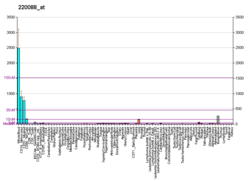The C5a receptor also known as complement component 5a receptor 1 (C5AR1) or CD88 (Cluster of Differentiation 88) is a G protein-coupled receptor for C5a. It functions as a complement receptor. [5] C5a receptor 1 modulates inflammatory responses, obesity, development and cancers. [6] [7] [8] From a signaling transduction perspective, C5a receptor 1 activation is implicated in β-arrestin2 recruitment via Rab5a, [9] coupling of Gαi proteins, [10] ERK1/2 phosphorylation, [11] calcium mobilization and Rho activation [12] leading to downstream functions, such as secretion of cytokines, chemotaxis, and phagocytosis.
Contents





